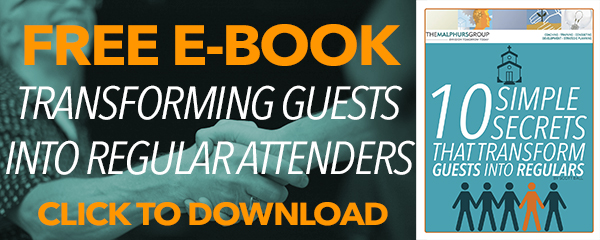Let’s keep first things first. Having a first-rate experience for newcomers should never be about becoming the coolest church in your town. It should always be about evangelism.
In the past, I’ve written about how our treatment of guests and our theology are connected. If you’re struggling with accepting whether or not your church should invest time, energy, and effort into improving your guest experience, I recommend you start there.
This article is aimed to be practical. I’m assuming that you already believe in the merits of improving your guest experience and are looking for concrete ways to improve.
Let’s dive in.
It starts online.
OK. I’m cheating a bit. “Online” isn’t your facility. But it’s worth remembering that a guest’s experience does not begin when they pull up at your church. It starts when they pull up Google to search for churches in your area and find yours or are referred to your website by a person. Your website is your first impression, and it must be a good one. 75% of consumers admit to making judgments on a company’s (read: your church’s) credibility based on the company’s website design.
I know your church isn’t a business. Still, people don’t quit their habit of judging organizations based on their website just because you’re a church and not a business. Churches don’t get a free pass. God might look at your heart, but Man looks at outward appearances. The people you want to reach aren’t looking at your heart–they’re looking at your website. For eight practical tips to improve your website, read our post on the topic here.
Can I find your church?
In the age of GPS, it’s easy to assume that no one gets lost anymore. False. I frequently travel in my work with TMG and visit lots of churches. Siri can get me close, but I’ve driven right past churches more times than I want to admit.
If you don’t have curb signage that is obvious and engaging, people will drive past your church and ignore it. The human eye was created by God to notice two things: color and movement. These psychological realities are why car dealerships put out those wavy-armed, inflatable men, and why retailers force teenagers with sandwich signs to spin them on the corner.
I’m not suggesting you use any of these tactics but learn from the principles. Feather flags work exceptionally well, but even a colorful A-frame will suffice. Check local code for signage rules and be sure to comply, but do everything you’re allowed to do — signage matters.
The most underrated aspect of your facility
Your on-site guest experience begins in earnest at the parking lot. We recommend that you reserve at least 6% of your parking spaces for guests. Train your regular attenders to park as far away as they’re able to walk. Call it “parking lot evangelism.” Make the most convenient spaces available to the people who will appreciate them the most.
Not every church needs a full parking team. But every church could benefit from having their first line id greeters be outside. Have umbrellas for inclement weather. Be a smiling face. Notice newcomers and connect them with a guide to children’s check-in. It doesn’t have to be extravagant; it just needs to be intentional.
If you pastor a very small church that has few guests, you might read this and think it’s too much. I challenge you to be ready for guests and see what God does. Don’t wait for the guests to build the system. Start small, but have a system that can scale as the demand grows.
What’s that smell?
The first sense that’s likely to be engaged when a guest comes in your church is your nose, not your eyes. It will take a moment for people to look around and process their environment. However, the smell of your facility will be instantaneous. If you’ve gone nose-blind to your building, have an outsider you trust tell you what the scent is.
Brewing coffee is a great way to have a pleasant scent. If that’s not possible, diffusing oils is another option. I caution you on this, though. People have allergies, and an overpowering, “fresh” scent can be worse than a stale one. Be careful.
Some churches think that to be guest friendly that they need to renovate their whole building. Since that’s unrealistic for most churches, they don’t renovate anything. This “all-or-nothing” mentality doesn’t need to rule the day.
Update your lobby with furniture that looks like it came from this century, not the 19th. Select masculine-leaning colors in paint choices, but not heavy colors: think grays and blues, but not black and navy.
[Bonus note: Make sure you have clean and well-stocked bathrooms. Ensure that the paper towel dispensers and soaps are re-filled. Check on this before you head home for the weekend. If your cleaning crew does their job before mid-week church activities, the bathrooms might need attention.]
Who is this space for?
A tremendous kid-friendly space begins with safety. Have a visible, convenient check-in station. If your church has not yet implemented a digital check-in station, now is the time. There are lots of good, affordable options like Planning Center, One Church Software, or Elvanto/Tithe.ly. Safety is the number one priority of parents, and having a sound check-in system shows your commitment to the safest environment possible.
Kid spaces should be fun. Use bright colors, but don’t worry about making murals. Sometimes churches get emotionally attached to murals in kids’ areas so that they’re afraid a kid will mess them up—sort of defeating the purpose — fun, bright, functional.
If you have multipurpose rooms, and one of those purposes is kids—skew the design towards the kids. You’ll never regret investing in making spaces fun for kids. Churches complain that they aren’t reaching young families, but few are building areas that are functional for young families. If you design your space with the young family in mind, you will be the outlier church that families want to keep attending.
Clean + Functional > Cool
Your worship space doesn’t need to have fancy lights or fog; it needs to be thought through intentionally. Often, churches have moved from having a band from having a choir. However, the stage was designed for a choir–not a band. As a result, it looks thrown together. The cable management is poor, and music stands crowd the stage. Trust me–it’s distracting. If your church has moved away from a choir, remove the risers, and re-design your stage space.
Lighting in the worship space doesn’t need to be fancy or expensive, but it needs to be thoughtful. If possible, avoid harsh fluorescent lighting. Don’t make the area too dark. Otherwise, it’ll feel like a show, but keeping the light dim helps people to be less distracted by the people around them. Balancing this takes thought, and you certainly will be constricted by your space (natural light, existing fixtures, etc.). Don’t waste money here. My encouragement is to be as thoughtful as you can be with the resources you have.
Where am I?
One of the things I tell churches I work with is that every wall in your building is a billboard communicating a message. I ask the churches I consult with to go through their high-traffic guest areas and look at every single wall. As you look at each wall, ask this question: “Does it communicate what I want it to communicate?”
Not every wall has to be extravagant! Some have nothing on them at all. But when you do put something on the wall—a sign—be sure you’ve thought it through.
There are two primary types of signage: way-finding signs and purpose signs.
Way-finding signs help guests figure out where to go—to the bathroom, the auditorium, kids drop-off, kids’ pick-up, information center, etc. Way-finding signage is an art—and a science. Here’s an article on the principles of way-finding design, and here’s another article specifically geared towards churches.
Purpose signage is signs used to tell guests who you are and what you value. You may have signs with your core values or mission on them. You might use signs to promote an upcoming outreach event or current sermon series. All of these signs are “purpose” signs. They give guests a glimpse of your organizational personality. I often see churches that have lots of signs about upcoming events, old core values banners, and artwork from the 1950s. These are purpose signs, too—but they usually lack intentionality.
Pay attention to your signage. It not only helps people get from Point A to Point B, but it shows people who you are. Be sure you’re telling the story you want a guest to hear.
The best next step
If you hide your information center in a corner or a hallway, don’t expect guests to visit. Put your guest connection area in a high-trafficked place that guests cannot miss.
If you don’t already have a guest connection area, start small. Buy a wide banner like the one linked here and get a counter-height bistro table. Having a portable solution is great at first. You can move it a few times until you find the best location.
Here’s a hack: don’t use a low 8-foot or 6-foot size table. First, it’s awkward for guests (who are standing) to talk to you if you’re sitting at a low table. Second, you’re going to be tempted to fill that table with lots of information and brochures. Don’t do it. A guest doesn’t need lots of information; they need the right information about their best next step. These are the reasons why we recommend a small bistro table if your church is just getting started with a guest connection area.
The small things
Finally, don’t miss out on the small details. The details are important. Look for water-stained ceiling tiles. Pay attention to holes and scuffs on the walls. Have volunteer teams filled with people who love to garden, and set them loose in a mission to keep weeds away.
Why do the details matter so much? When your church ignores the details, guests subconsciously think, “If they can’t take care of this building, how can they care for my family and me spiritually?” Yes, it’s that big of a deal!
Your facility can be an asset or a liability in your Great Commission mission. You get to decide what it will be.

Scott Ball is the Vice President and a Lead Guide with The Malphurs Group. He lives in East Tennessee with his wife and two children. (Email Scott).



